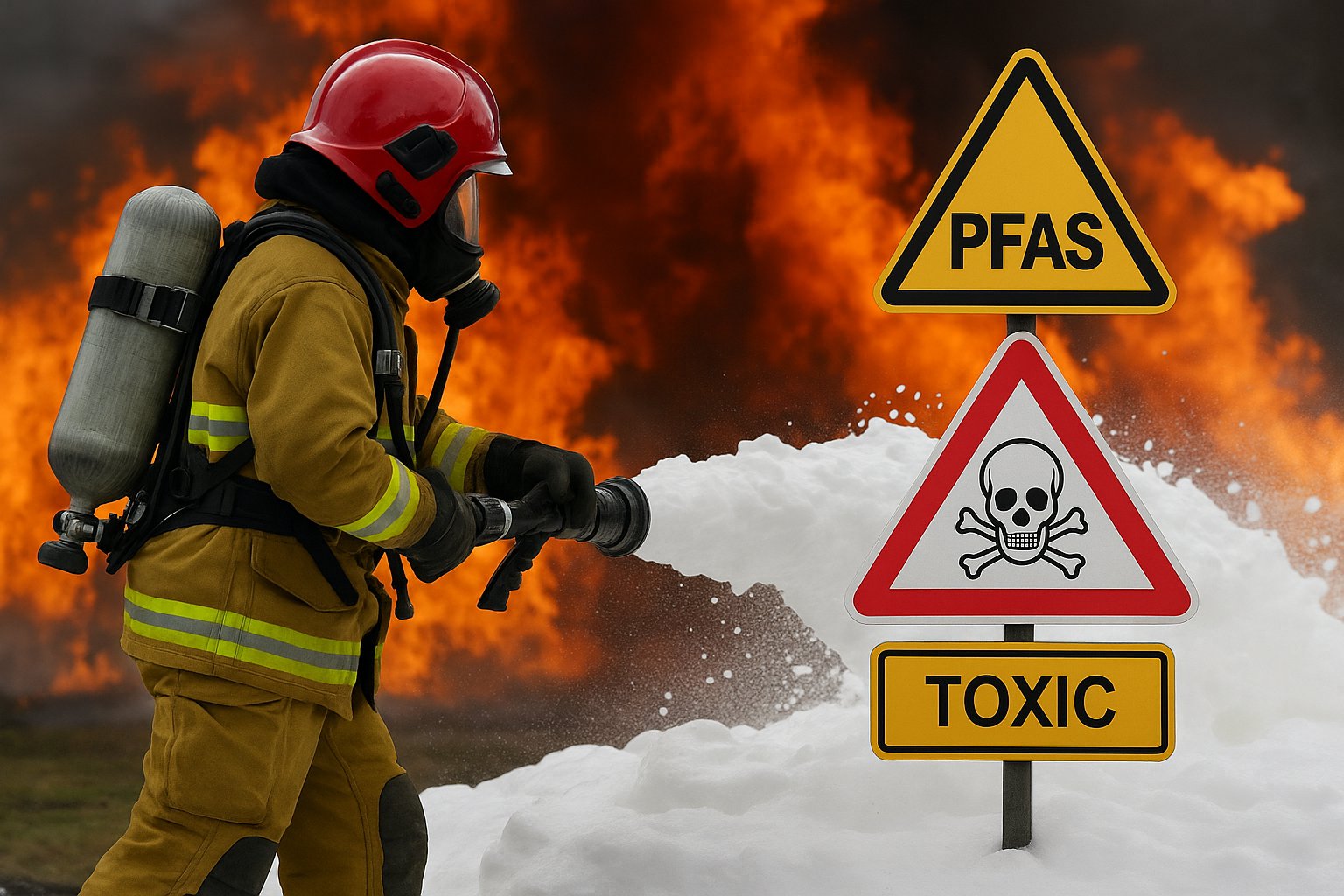AFFF (Aqueous Film-Forming Foam) lawsuits are rapidly increasing nationwide as individuals link severe health conditions to PFAS, hazardous chemicals found in firefighting foam. The egregious AFFF lawsuits claim the manufacturers knowingly abused military service members, firefighters, and civilians by producing dangerous foam products and failing to give any meaningful notice about the long-term health hazards these foam products posed.
As more research is published and the public becomes increasingly aware of PFAS-related health risks, public pressure on AFFF manufacturers continues to grow. Communities, environmental groups, and advocacy organizations are calling for stricter regulations, faster remediation, and greater compensation for affected individuals.
Individuals exposed to AFFF who had cancer or developed health related illnesses are now getting their justice through the legal system. This article will cover the history, the latest news, settlement progress, what compensation is available, and what people affected can do immediately.
What Is AFFF and Why Is It Dangerous?
To achieve a genuine understanding for the scope of the AFFF lawsuit, it is critical to first understand what AFFF is on a fundamental level, how it works, and the harmful health effects it presents.
What is AFFF?
AFFF stands for Aqueous Film-Forming Foam. Firefighters use this synthetic foam to extinguish highly flammable liquid fires, including those caused by jet fuel, gasoline, and other volatile chemicals. AFFF works well to put out flames by placing a barrier between the fuel surface and the oxygen, thereby preventing the fire from re-igniting. This technology has been widely deployed:
- On military bases where training exercises and actual emergency scenarios often involve flammable fuels.
- At airports, where AFFF is required by FAA regulations for crash response.
- By municipal firefighters who encounter fuel-related fire hazards during industrial or vehicular fires.
- In industrial facilities that store or transport flammable materials.
What makes AFFF toxic?
The inherent danger is due to the use of PFAS (per and polyfluoroalkyl substances) in the vast majority of AFFF formulations. PFAS, a class of over 9,000 manufactured substances, are derived from chemicals like PFOS, PFOA, and other long-chain compounds. Chemical manufacturers developed PFAS for their unmatched resistance to heat, water, and oil. However, the human body and the environment cannot metabolize or break down these chemicals, leading to their accumulation over time.
The Environmental Protection Agency (EPA) and Centers for Disease Control and Prevention (CDC) have confirmed that PFAS are linked to a wide range of serious health risks:
- Kidney cancer: PFAS chemicals accumulate in the kidneys, where they can cause cell mutation and cancer.
- Testicular cancer: Studies among U.S. military firefighters show a high incidence rate.
- Thyroid disease: PFAS affect hormone regulation.
- Liver damage: Chronic PFAS exposure leads to enzyme and lipid profile abnormalities.
- Ulcerative colitis: The immune system responds aggressively to prolonged PFAS exposure.
- Immune dysfunction: PFAS exposure weakens the body’s ability to fight infection and respond to vaccines.
These health effects have been documented over decades, yet manufacturers continued to market AFFF without proper warnings.
Sources: Sokolove Law, Dolman Law
Who Is Suing Over AFFF Exposure?
The AFFF litigation is broad, covering a variety of plaintiffs. It includes workers, military veterans, and entire communities whose water supplies have been contaminated.
Common plaintiffs in AFFF lawsuits:
- Firefighters (civilian and military): They directly handled AFFF during training exercises, vehicle fires, and industrial blazes. Routine exposure, sometimes without proper protective equipment, puts them at high risk.
- Airport personnel: Workers involved in aircraft rescue and firefighting (ARFF) operations, who are required by regulation to use AFFF, are among the most exposed.
- Oil and chemical plant workers: These industries use AFFF for safety and compliance. Long-term exposure through foam systems or cleanup operations is common.
- Military veterans, especially Navy personnel: Ships and airbases routinely used AFFF in enclosed spaces. Veterans may have inhaled vapors or absorbed chemicals through their skin over long deployments.
- Communities near contaminated water sources: PFAS leaches into groundwater and nearby wells. Residents near military installations, refineries, or airports have unknowingly consumed contaminated water for years.
What do plaintiffs claim?
The lawsuits argue that AFFF manufacturers:
- Knew about the health hazards of PFAS for decades, dating back to the 1960s.
- Possessed internal studies showing toxicity and bioaccumulation.
- Chose profit over safety, continuing production and sales while downplaying or denying risks.
- Failed to label or warn users about potential health effects.
- Neglected to develop safer alternatives, even as technology improved.
These points form the basis of negligence and product liability claims.
Which Companies Are Being Sued?
AFFF lawsuits are directed at companies that manufactured or distributed PFAS-based foams. These include both chemical producers and equipment suppliers.
| Company | Known For |
|---|---|
| 3M | Producing AFFF since 1960s |
| DuPont | PFAS manufacturing |
| Chemours | DuPont spin-off handling PFAS |
| Tyco (Johnson Controls) | Firefighting equipment |
| Kidde-Fenwal | Fire suppression systems |
These firms are accused of either producing harmful formulations or supplying them to users without sufficient disclosure of risks.
What Is the AFFF MDL (Multidistrict Litigation)?
Due to the large number of lawsuits, the judicial system has consolidated the litigation into a single forum known as a Multidistrict Litigation (MDL) to streamline evidence discovery, witness testimony, and trial scheduling.
Centralizing the lawsuits
MDL No. 2873 is based in the District of South Carolina under Judge Richard Gergel. It handles claims involving:
- Personal injury lawsuits: Firefighters and veterans who developed cancer.
- Municipal contamination suits: Cities and water districts suing for cleanup costs.
As of early 2025:
- Over 6,400 cases are consolidated.
- Discovery is ongoing, with key bellwether trials expected soon.
- The outcomes of early trials may set precedents for future settlements.
Sources: Miller Law Group
AFFF Cancer Connection: What the Science Says
Numerous scientific and government reports have linked AFFF exposure to elevated cancer risks. These findings form the backbone of injury claims.
Peer-reviewed findings
The Agency for Toxic Substances and Disease Registry (ATSDR), part of the U.S. Department of Health and Human Services, concluded that exposure to PFAS:
- Alters kidney function and increases kidney cancer risk
- Causes Leydig cell tumors in testicles (shown in animal studies)
- Interferes with hormonal regulation
- Damages liver enzymes and bile ducts
- May increase risk for pancreatic and prostate cancer
The accumulation of PFAS in blood and tissues is slow, meaning even low-level exposure over time becomes dangerous. Blood serum PFAS levels can now be tested to provide legal and medical documentation.
What Cancers Are Being Claimed in Lawsuits?
AFFF-related lawsuits generally involve the following cancers:
| Cancer Type | Connection to AFFF Exposure |
| Kidney cancer | Strong link through studies |
| Testicular cancer | Well-documented by ATSDR |
| Bladder cancer | Increasingly reported |
| Pancreatic cancer | Under investigation |
| Liver cancer | PFAS accumulates in liver |
| Non-Hodgkin’s Lymphoma | Suspected in foam users |
Additional symptoms, such as thyroid disorders, reproductive dysfunction, and high cholesterol, are also being reviewed in emerging claims.
Recent AFFF Lawsuit Settlements (2023–2025)
Litigation has prompted several major settlements related to municipal water contamination. Personal injury settlements are expected to follow.
Key settlement milestones:
| Date | Company | Amount | Claim Type |
| June 2023 | 3M | $10.3 billion | Water contamination |
| 2023 | DuPont | $1.19 billion | Municipal systems |
| 2024 | Chemours | $671 million | Contamination claims |
Note: These figures reflect claims brought by states, cities, and utilities. Firefighters and veterans with cancer are still waiting for trial outcomes or settlement frameworks.
How to Qualify for the AFFF Lawsuit
Not everyone exposed will qualify. Legal teams require strong evidence linking PFAS exposure to a health condition.
You may qualify if:
- You regularly used AFFF during work or military service.
- You lived near a site with known PFAS contamination.
- You were diagnosed with a related cancer, especially kidney or testicular.
- You have medical and employment records that demonstrate exposure.
Attorneys often work with toxicologists and oncologists to assess the strength of your claim.
How to File Your AFFF Lawsuit Claim
Step-by-step legal filing:
- Contact a specialized attorney experienced in toxic torts.
- Submit military or occupational history showing PFAS exposure.
- Compile all relevant medical records, including cancer diagnosis, treatment, and prognosis.
- Allow case evaluation—your attorney will determine whether to file locally or under the MDL.
Early case selection in the MDL may lead to higher settlement values. Filing sooner helps preserve evidence and eligibility.
Compensation in AFFF Lawsuits
Damages awarded in successful cases may include:
- Medical expenses: Hospitalization, chemotherapy, surgeries, medication.
- Lost income: Wages lost during treatment and recovery.
- Pain and suffering: Physical and emotional trauma.
- Loss of future earnings: If illness leads to permanent disability.
- Punitive damages: For egregious corporate negligence.
Payouts vary based on diagnosis, age, life expectancy, and impact on livelihood. Legal analysts expect most personal injury settlements to range from $150,000 to $500,000.
However, plaintiffs with severe or fatal cancer diagnoses may recover substantially higher amounts, especially in cases involving long-term exposure, strong documentation, or punitive damages against negligent manufacturers.
Government and Military Response
What is the DOD doing?
The U.S. Department of Defense is under pressure to reduce PFAS exposure:
- Over 700 sites are under review or cleanup for PFAS contamination.
- Military firefighting teams are testing fluorine-free foam as an alternative.
- All branches must phase out PFAS-based foams by October 2026.
Regulatory actions
- The EPA has proposed enforceable PFAS drinking water limits.
- Several state-level bans on AFFF use are already in place.
- Congress is pushing the PFAS Accountability Act to fund research, cleanup, and victim compensation.
FAQs About the AFFF Lawsuit
Is AFFF still being used?
Yes, although regulations are tightening. The military and airports are transitioning to safer substitutes.
Can family members of firefighters file claims?
Possibly. Secondary exposure through contaminated gear, clothing, or household water can qualify under some claims.
Do I need to prove my cancer was caused only by AFFF?
No. Courts recognize cumulative exposure and will consider occupational context, blood tests, and scientific probability.
Conclusion: Why You Should Take Action
The AFFF lawsuit is a vital legal movement helping individuals and communities harmed by chemical negligence. PFAS exposure has lifelong consequences, and major manufacturers failed to protect those most at risk.
If you or a family member were exposed to firefighting foam and developed cancer, now is the time to step forward. With thousands of cases already in motion and key trials underway, this is your opportunity to pursue compensation and justice.
Don’t wait. Speak with a qualified legal team and preserve your rights before deadlines pass.




